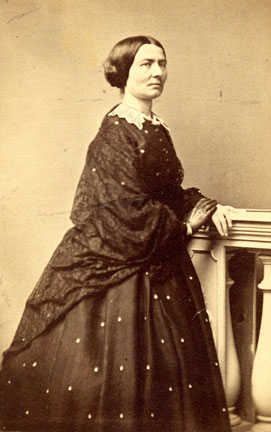Aasta Hansteen facts for kids
Aasta Hansteen (born December 10, 1824 – died April 13, 1908) was a famous Norwegian artist, writer, and an early supporter of women's rights. She is known for her paintings and for speaking up for women.
Life and Career
Aasta Hansteen was born in Christiania, which is now Oslo. Her father, Christopher Hansteen, was a well-known professor. He taught astronomy and geophysics at the University of Oslo.
Aasta started her art studies in Copenhagen from 1840 to 1841. There, she learned how to draw. She then studied for three years at the Kunstakademie Düsseldorf in Germany. She became known for her detailed painting style. Her work was shown at the 1855 World's Fair in Paris.
After her studies, she returned to Norway. She settled in Christiania and became the city's only portrait artist for several years. Her most famous painting is likely the portrait of her father. You can see it at the National Gallery of Norway.
Aasta took a break from painting because so many people wanted her portraits. She moved to Telemark, where she became interested in Norwegian dialects. When she moved back to Christiania, she studied with the language expert Ivar Aasen. In 1862, she secretly published a small book. It was written in Nynorsk, a form of Norwegian. This made her the first woman to publish in this language.
On April 9, 1880, Aasta and her foster daughter, Theodora Nielsen, sailed to the United States. She lived there for nine years, from 1880 to 1889. She spent most of her time in the Boston area and some time in the Midwest, like Chicago. Aasta Hansteen met many important reformers there. These included Lucy Stone, Julia Ward Howe, and Wendell Phillips.
She earned money by writing for a Norwegian newspaper called Verdens Gang. She also painted portraits for people. In 1889, she returned to Norway. She became very active in the women's movement again. She joined the Norwegian Association for Women's Rights and wrote often about women's rights in newspapers.
Aasta Hansteen passed away in Kristiania, which is now Oslo. She was known for being a strong and independent person. She often went to cafes and markets by herself. This made her a well-known figure in Oslo.
Legacy
Some people believe that Henrik Ibsen used Aasta Hansteen as a model. She might have inspired the character Lona Hessel in his play The Pillars of Society. She is also thought to be the inspiration for the main character in Gunnar Heiberg's play Aunt Ulrikke.
The Norwegian musician Agathe Backer Grøndahl dedicated some of her music to Aasta. A bust of Aasta, made by Gustav Vigeland, marks her grave. It is located in Vår Frelsers gravlund in Oslo. Streets in Stovner (Oslo) and Trondheim are named after her. A statue of Aasta Hansteen, made by Nina Sundbye, stands in the Aker Brygge area of Oslo.
A large natural gas field in the Norwegian Sea is also named after her. The Aasta Hansteen gas field started producing gas on December 16, 2018. It is located about 300 kilometers west of Sandnessjøen. Its floating platform is very tall, even taller than the Eiffel Tower.
Selected Works
- Skrift og Umskrift i Landsmaalet, 1862
- Kvindens stilling i Verden, i Nordisk Maanedsskrift for folkelig og kristelig Oplysning, 1871
- Kvinden skabt i Guds Billede, 1878
- Kristi kirke i det nittende aarhundrede, 1897
- Dikt i (Ivar Aasens) landsmaal. 1862–67, 1908



